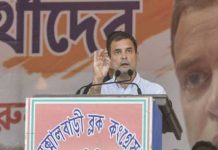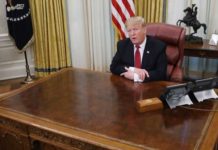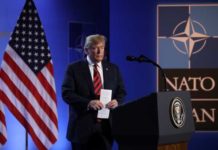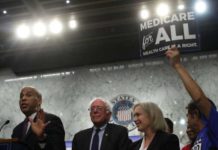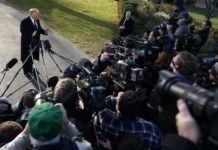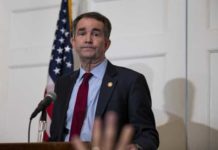
ISIS is defeated, the Taliban wants to make peace, and US troops will soon be coming home from Syria and Afghanistan. Talks with North Korea to end its nuclear program are going well, the US is helping restore democracy in Venezuela, and America’s renewed toughness on Iran has thwarted its designs in the Middle East.
That’s likely the rosy picture President Donald Trump will paint during the foreign policy portion of his Tuesday night State of the Union address. The reality, however, is far more complicated.
It’s normal for a president to boast about his accomplishments during a high-profile speech like this, and Trump can certainly point to some achievements when it comes to his foreign policy. The problem is that his victory lap — especially on ISIS and North Korea — is premature.
The successes Trump is likely to flaunt during his address before Congress could come true — they just haven’t yet. Which means the state of the union’s foreign policy is, at best, in limbo.
Here’s what you need to know about Trump’s major foreign policies ahead of the big speech.
ISIS’s territory is mostly gone, but thousands of ISIS fighters remain
In interview after interview leading up to Tuesday’s State of the Union speech, the Trump administration has signaled that the president will make a “significant” announcement about ISIS.
“When I took over, Syria it was infested with ISIS. It was all over the place. And now you have very little ISIS and you have the caliphate almost knocked out,” Trump told CBS’s Margaret Brennan before Sunday’s Super Bowl. “We will be announcing in the not too distant future 100 percent of the caliphate. … We’re at 99 percent right now, we’ll be at 100.”

The president clearly wants to be able to declare “mission accomplished” during his address on Tuesday and to tell the American people that, thanks to him, US troops are finally coming home from Syria.
But while Trump is correct to say that ISIS has lost nearly all of its territory — a major accomplishment, since in 2014 it controlled an area of land the size of Britain — it’s not right to say the terrorist group is completely gone.
“Losing territory does not mean a group is defeated,” Shanna Kirschner, an expert on Syria at Allegheny College, told me.
Trump’s State Department seems to agree. In a Monday statement, deputy spokesperson Robert Palladino said, “Despite the liberation of ISIS-held territory in Iraq and Syria, ISIS remains a significant terrorist threat,” adding that “collective action is imperative to address this shared international security challenge.”
And according to reports by both the Pentagon and the US intelligence community, ISIS still has thousands of fighters spread across Syria and Iraq. One estimate from last August found that ISIS had as many as 17,100 fighters in Syria, and about 30,000 total between the two countries.
With that many fighters still active, the group can continue to wreak havoc in the region. Just three weeks ago, it bombed a restaurant in Manbij, Syria, killing at least 15 people, including four Americans: two troops, a Pentagon civilian, and a military contractor.
So although ISIS is certainly far weaker as an organization than it was at its height, it’s still a long way from being truly “defeated,” no matter how badly Trump might want you to believe otherwise.
What’s worse, there’s a possibility that the withdrawal of America’s 2,000 troops from Syria — which Trump officially ordered late last year — will make it easier for ISIS to regain territory.
Trump wants you to think the US has won in Afghanistan so he can bring troops home
In his State of the Union speech, Trump may also boast about how he is ending yet another of America’s “Endless Wars”: the war in Afghanistan.
Just like with Syria, Trump has made no secret of his desire to withdraw US troops from Afghanistan, despite the objections of many current and former officials. And just like with Syria, Trump seems to be trying to convince the American people that it’s time to bring US troops home because the enemy has basically been defeated:
As with Syria and ISIS, Trump is partially correct here — and partially full of it.
The US and the Taliban are, in fact, “talking peace after 18 long years.” Last week, the US and the Taliban agreed on the broad outlines of a long-sought peace deal that would see US troops leave the country, perhaps within 18 months.
Under the proposed deal, the Taliban, which controlled Afghanistan and harbored al-Qaeda prior to the 9/11 attacks, would promise never again to allow a terrorist organization to operate in the parts of the country under its control. In return, at least some if not all US troops would leave the country, as long as the Taliban also agrees to a ceasefire and to engage in talks with the Afghan government.
But the reason the Taliban is now willing to sit down and negotiate with the US is not because we “have hit them so hard” that they are ready to give up and make peace, as Trump would have you believe.
In fact, it’s just the opposite: The Taliban is more powerful now than it has been since the 2001 US invasion. According to the Pentagon, the group now controls or contests more than 40 percent of the country.
So why, then, is the insurgent group all of a sudden willing to negotiate? One reason might be that the Taliban knows just how badly Trump wants to get out of Afghanistan — and plans to use that to its advantage.
Here’s how that could work: The Taliban agrees to just enough to give Trump the cover he needs to pull US forces out; then, once the US is gone, the Taliban just does whatever it wants since the US isn’t there to enforce the deal anymore.
That’s the fear that some experts have about the current diplomatic effort. But even if the Taliban is negotiating in good faith, it would be folly for the president — and the American people — to believe that the group is even close to being defeated.

Trump’s second summit with North Korea’s Kim Jong Un doesn’t equal success
Trump is extremely likely to tout his progress with North Korea during the State of the Union address. And while he’s right to say that relations between Washington and Pyongyang are better now than they were in 2017 — when it seemed both sides were headed for war — his certainly positive comments won’t reflect the reality.
Report after report after report shows that despite months-long negotiations with North Korea in pursuit of a deal that would see the country give up its nuclear weapons and dismantle its nuclear and missile production facilities, Pyongyang has instead improved its arsenal.

The US has made little headway in changing that trajectory.
In August, Secretary of State Mike Pompeo named Stephen Biegun, a former Ford Motor Company executive, to be America’s special envoy for North Korea. His main job is to lead the day-to-day, working-level negotiations with Kim’s regime.
The problem is that while Biegun has met with allies in Asia, including South Korea, multiple sources have told me that he has struggled to make any progress with his North Korean counterparts and is at this point effectively powerless. However, on Tuesday he will arrive in Pyongyang to meet with his counterpart ahead of a second Trump-Kim summit later this month.
Biegun’s tepid progress isn’t entirely his fault.
Trump promised Kim in Singapore that he would sign a peace declaration that would semi-officially end hostilities between the US and North Korea. That’s something Pyongyang has wanted for years, in part because it would give the regime political space to reduce its nuclear arsenal, but only Trump has seemed willing to offer it.
Other administrations partly didn’t want to sign the declaration because it would reduce pressure on North Korea to end its nuclear program, and they didn’t want to scare South Korea — a staunch US ally.
So it makes sense that the North Koreans only want to deal directly with Trump and, when they absolutely have to, Pompeo. The secretary met with Kim in October and agreed Trump and Kim should meet for a second summit, which is now planned for the end of February, likely in Vietnam.
It’s unclear whether Trump’s self-proclaimed negotiating prowess can end the months-long impasse. America is demanding that North Korea offer a full, detailed list of its nuclear inventory before the US lifts any sanctions on the country, and Pyongyang is demanding UN-imposed sanctions be lifted before it offers the full list and seriously begins to downgrade its nuclear capabilities.
Perhaps with the tough road ahead in mind, Trump sounded less certain last week that North Korea would ever give up its nuclear weapons. “Decent chance of denuclearization,” he tweeted last Wednesday. “Time will tell what will happen with North Korea.”
That’s a far cry from the comments Trump made in June — just hours after meeting with North Korean leader Kim Jong Un for the first time — in which the president stated that there was “no longer a Nuclear Threat from North Korea.”
It’s possible Trump will outline some behind-the-scenes progress with North Korea during Tuesday’s speech. But he’s more likely to brag about something he shouldn’t — at least not yet.
The US-led push for regime change in Venezuela hasn’t worked — yet
Trump will likely claim that his pressure on Venezuela’s socialist dictator will inevitably lead to a new dawn of democracy in the South American nation.
But that outcome is by no means inevitable; as of right now, it’s anyone’s guess how the crisis in Venezuela will play out.
Venezuela is currently in the midst of a political standoff between two men who both claim to be the legitimate president of Venezuela: Nicolás Maduro, who was reelected president in May 2018, and opposition leader Juan Guaidó.

Guaidó claims the 2018 election was rigged and that he, as the head of the National Assembly (the country’s legislative body), is now the rightful president according to the country’s constitution.
The United States, along with Latin American, European, and other countries, have officially recognized Guaidó as Venezuela’s interim president and called Maduro’s claim to the presidency “illegitimate.” But Maduro has responded with defiance and has so far shown no sign of stepping down. That’s led to hundreds of thousands of protesters taking to Venezuela’s streets for weeks, calling for him to resign.
There are good reasons why Guaidó and the anti-Maduro movement at home and abroad have found an audience. Millions have fled the country due to a crippling economic downturn. Inflation is through the roof. Hunger rates have skyrocketed. And diseases once thought eradicated from Venezuela have sparked a new health crisis. Unsurprisingly, all this and more have made Maduro an unpopular leader.
But there’s a problem: Even with US support, Maduro probably isn’t going anywhere anytime soon.
“It’s most likely that Maduro will remain in power and that Venezuela will continue to worsen — remaining in its miserable, critical condition,” Ronal Rodriguez, an expert at the University of Rosario’s Venezuelan Observatory in Colombia, told me in January.
Here’s why: The leadership of Venezuela’s armed forces remains fiercely loyal to Maduro, officials and experts say. Last month, for example, the military quickly put down an uprising from 27 anti-Maduro national guard members who seemingly aimed to foment the president’s ouster. Plus, Maduro loyalists control many of the country’s other important institutions, like the supreme court.
That hasn’t stopped the Trump administration from putting pressure on Maduro. Last week, the US Treasury Department placed sanctions on Petroleos de Venezuela, the behemoth state-owned oil and natural gas company that provides the country with thousands of jobs and billions in revenue. Maduro uses the enterprise to reward his cronies and buy loyalty. For instance, he offers top members of Venezuela’s military a stake in the energy giant.
As of now, the only thing that seems certain is that the US-led effort to remove Maduro and officially install Guaidó will continue. What’s much less certain is if it will actually work.
Trump says his Iran pressure is working. Not quite.
During the State of the Union, the president will almost certainly claim that his decision to pull the US out of the Iran nuclear deal and reimpose sanctions on the country last year has added immense pressure on the Iranian regime, stifled its regional ambitions, and put it even further from potentially getting a nuclear weapon.

But all those claims directly contradict his administration’s own findings.
First, while the sanctions have put some additional pressure on the Iranian regime, European countries such as Germany and France have not only refused to follow the US in reimposing sanctions on Iran, they’ve actually created a workaround that allows them to continue doing business with the country despite US sanctions. That could substantially blunt the economic impact of the Trump administration’s sanctions.
In fact, a new report released Monday from the Pentagon’s inspector general finds that “US sanctions re-imposed on Iran in August and November 2018 have had limited effect on Iran’s ability to operate in Syria.” The report does say that additional sanctions could change that, but as of now, the impact has been minimal at best.
Second, Trump has long argued that the Iran nuclear deal wouldn’t have stopped the country from getting a nuclear weapon and that staying in the deal would have actually lead it to acquire nuclear weapons in “just a short time.”
But according to a report issued by top US intelligence officials last week, Iran’s “continued implementation” of the deal — even after Trump pulled the US out of it — “has extended the amount of time Iran would need to produce enough fissile material for a nuclear weapon from a few months to about one year.”
What’s more, the report warns that “Iranian officials have publicly threatened” to “resume nuclear activities that the [nuclear deal] limits — if Iran does not gain the tangible trade and investment benefits it expected from the deal.”
So not only has Trump’s pressure on Iran not accomplished what he wanted it to, his decision to pull out of the nuclear deal could actually push Iran to try to pursue a nuclear weapon.
Which means that any victory lap Trump tries to take on Iran during his State of the Union address will be based purely on fantasy, not reality.
Sourse: breakingnews.ie
0.00 (0%) 0 votes


